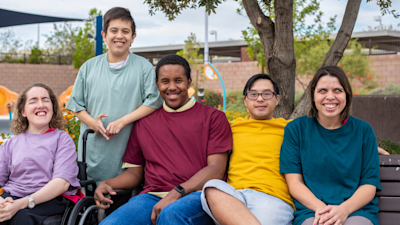Bi+ Visibility Day is observed annually on 23 September to recognise and celebrate bi+ people.

Since 1999, Bi Visibility Day has been celebrated on 23 September, raising bi awareness and challenging bisexual & biromantic erasure.
Bi Visibility Day is an opportunity to celebrate diverse bi identities, listen to the voices of bi people, and take steps towards positive change.
At Life Without Barriers, we celebrate diversity, and we practice inclusion. We want our employees to be accepted and welcomed for the difference and diversity they bring. This means providing a safe and supportive workplace for everyone, inclusive of culture, ethnicity, faith, age, disability, sexual orientation, gender identity/expression, intersex status, and relationship status. We want our employees to feel valued, respected and connected.
To celebrate Bi Visibility Day, we have put together some key facts to help you learn more about bisexuality, the challenges the bi+ community faces and what you can do to support the bi+ community.
What is bisexuality?
A person might consider themselves bisexual if they are attracted to more than one gender and/or they have had intimate experiences with more than one gender and/or they identify as bisexual.
Robyn Ochs, a bisexual educator, speaker, and activist, defines bisexuality as, “I call myself bisexual because I acknowledge that I have in myself the potential to be attracted – romantically and/or sexually – to people of more than one gender, not necessarily at the same time, not necessarily in the same way, and not necessarily to the same degree.”
It is essential to differentiate between behaviour (the things people do) and self-identification (the way people label themselves). The former is objective and descriptive, based on observations of how people interact with each other, but the latter is subjective and personal and may not always align with behaviour.
What does bi+ mean?
Bi+ is a collective identifier or umbrella term that refers to people who self-identify as any of the many labels used by people whose multi-gender attraction (MGA) forms part of their identity. These labels include bisexual, pansexual, queer, fluid, polysexual, omnisexual, and many others, and people who openly embrace their multi-gender attraction but choose not to apply any label to themselves.
What are some of the issues facing the Bi+ community?
Bi+ people can find themselves targeted by a wide range of negative behaviours, and these can be roughly grouped into two categories: biphobia and bi-erasure.
Biphobia is prejudice, fear or hatred directed toward bisexual people. Biphobia occurs both within and outside of the LGBTQIA+ community.
Bi-erasure is a pervasive problem in which the existence or legitimacy of bisexuality (either in general or regarding an individual) is questioned or denied outright. It can be a direct result of conscious biphobia but is often an accidental side-effect of people simply forgetting that bisexuality exists.
Biphobia and bi-erasure significantly impact the mental health and well-being of bisexual people. Bisexual people are more likely to be diagnosed and treated for a mental disorder or anxiety and have higher levels of psychological distress than gay or lesbian people.
What can I do to support the bi+ community?
Believe us. Bi+ people exist, and all bi+ identities are valid. It is all too common for bi+ people to be challenged and scrutinised on their identity.
Don’t assume someone’s identity based on their current or previous partner(s). The gender of someone’s partner doesn’t define them.
Recognise and challenge biphobia and bi-erasure.
Use inclusive language. Think carefully about who you’re talking about. You can erase and exclude bi+ people when using words like ‘gay’ as catch-all terms, especially if you don’t know whether everyone you’re referring to identifies in that way.
Celebrate us! Amplify and celebrate bi+ people and their stories.


